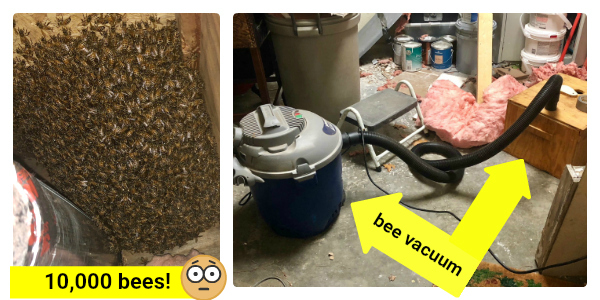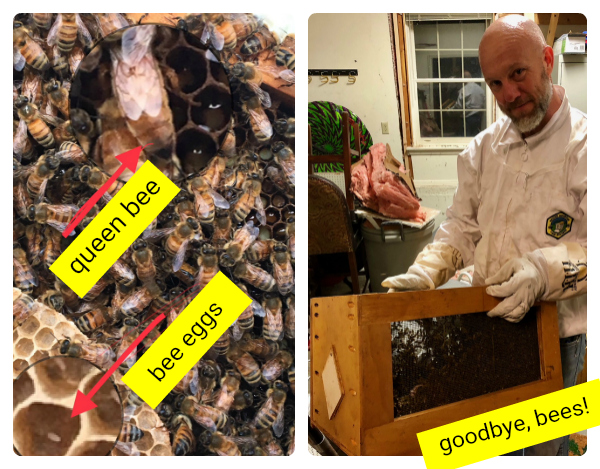To bee or not to bee: One mom’s un-bee-lievable day
Bee removal in Northwest Arkansas
Last Saturday, we saw something we’ve never seen before. A large, black cloud of swarming bees appeared in our backyard, hovering over the deck like a chaotic storm. We spotted it from the kitchen window and watched as they clustered on a wood railing.
 About 10 minutes later, they were gone. We assumed they were just passing through on their way to the hive or wherever it is bees go.
About 10 minutes later, they were gone. We assumed they were just passing through on their way to the hive or wherever it is bees go.
But two days later, when the construction crew showed up to continue working on the home addition we’re building, we received some alarming news. That swarm of bees didn’t just pass through. They moved in.
As the builders began work, a few concerned bees emerged from the exterior wall of our garage. That’s when we realized the swarm had likely slipped in through a crack between the dryer vent and the brick wall, setting up shop within the ceiling. The builders cut away a portion of the garage ceiling, spotted a hive covered in bees, and then promptly announced they’d be taking the rest of the day off.
I didn’t blame them. There’s not enough hazard pay in the world to make me swing a hammer near a beehive. So I Googled “bee removal” until I found a website that listed beekeepers in my area. I texted the one closest to us and was relieved when he wrote back with this message: “I can help. What’s your address?”
He showed up after 6 p.m. that same night. His name is Troy Thurber, and he’s a mechanical engineer by day and a rescuer of bees by night. He donned a white coat and mesh-covered hood and went to work. I’d planned on keeping a safe distance. Just the thought of a clump of stinging insects behind the wall was enough to give me a serious case of hee-bee jeebies – heavy on the bees.
But when Tom came into the kitchen to report that Troy estimated at least 10,000 bees in the clump, my curiosity forced me to go look. Even though I fully expect that image to show up in a nightmare one day soon, it was a fascinating thing to see.

Because the bees were in such an odd spot, Troy said he’d use his bee vacuum to collect them. Bee vacuum? Yes, bee vacuums really do exist but it’s not something you can buy on Amazon. Troy built his own using a shop-vac and a special bee box with a hole for the vacuum hose. bee removal in northwest arkansas
By that time, Tom and I were peppering Troy with questions. Why did the bees swarm that way? Where did they come from? Why did they pick our house? bee removal in northwest arkansas
Troy knew all the answers, and hearing the bees’ backstory changed my perspective. Apparently, the bees swarmed because they were running out of space in their old hive. (Who among us hasn’t complained about a lack of storage space at home?) The bees “swarmed” in order to split one colony into two. So the bees produced a special egg that could hatch a new queen bee. But before the new queen was hatched, the old queen had to move out of the hive along with about half the worker bees. Troy pointed to our buzzing clump of ceiling bees and said, “There’s an old queen in this group.” bee removal in northwest arkansas
“Why does the old queen have to be the one to leave?” I asked.
“Because if she doesn’t, the old queen and the new queen will fight to the death,” he said.
“And the old queen would lose?” I asked.
“Yes, because the new queen is younger and stronger.”
I felt an immediate kinship with the old queen. I’m a middle-aged queen myself, and I’d be furious if some new, young queen (who probably has no cellulite or stretch marks) suddenly popped up in my hive.
Troy described how the swarm democratically chooses a new home and probably picked ours because it was fairly close to their old hive and because they found that lucky crack between the dryer vent and the brick wall. As the vacuum gently sucked bees out of the ceiling, Troy told us how most of the bees we see are female bees – the ones who do all the real work.
“Of course they are!” I said. Tom rolled his eyes and asked about what the male bees do.
“Nothing, really. They don’t collect pollen or nectar. They don’t even feed themselves,” Troy said. “They just hang around waiting for a chance to mate with the queen.”
“That figures,” I said, crossing my arms with a harrumph. (I could see Tom mentally envisioning how awesome male bees have it.)
But then we learned that, once the male bees mate, they die – either from the mating ritual itself or because the weather turns colder, which is when female bees kick the men out of the hive causing them to die from starvation or hypothermia. (That’s when Tom decided that being a male bee didn’t sound that great after all.)
After a few hours, Troy was ready to leave with his box of 10,000 buzzing bees. As any woman can imagine, I was immensely grateful to the beekeeper, who charged us nothing for the work. Not only is he a man who vacuums, he also knows how to get a swarm of bees out of the ceiling. Feeling almost sorry to kick them out, I leaned down over the box of bees and said, “You’re going to a good home!”
 Troy said he would call us sometime next year when honey from the hive is ready to sell. We’re already looking forward to putting honey from our very own ceiling bees into a morning cup of hot tea. bee removal in northwest arkansas
Troy said he would call us sometime next year when honey from the hive is ready to sell. We’re already looking forward to putting honey from our very own ceiling bees into a morning cup of hot tea. bee removal in northwest arkansas
In the meantime, I’m happy to report that things are getting back to normal around here, and we are thankfully bee-free once again.
 Gwen Rockwood is a mom to three great kids, wife to one cool guy, a newspaper columnist and co-owner of nwaMotherlode.com.
Gwen Rockwood is a mom to three great kids, wife to one cool guy, a newspaper columnist and co-owner of nwaMotherlode.com.
